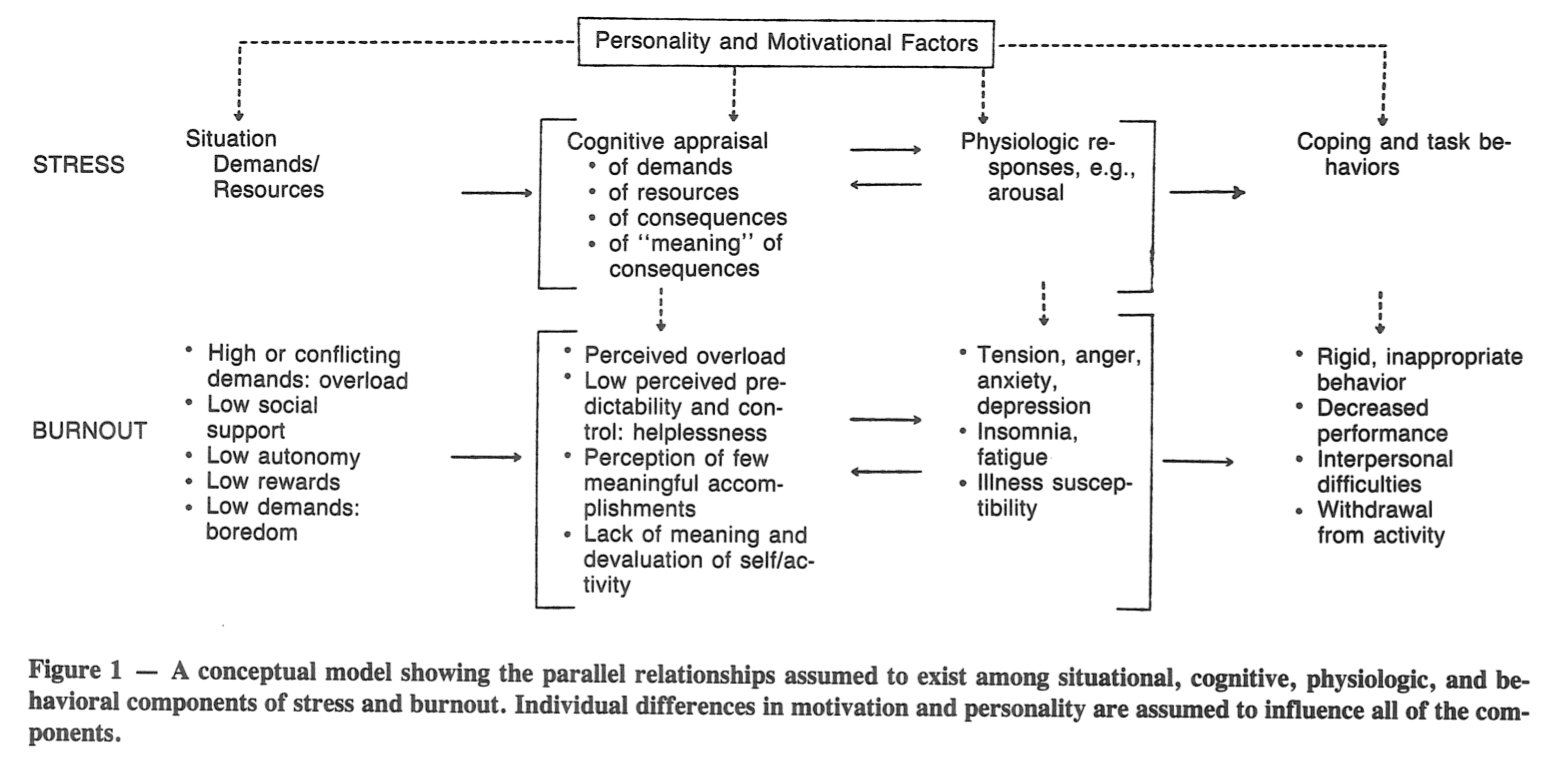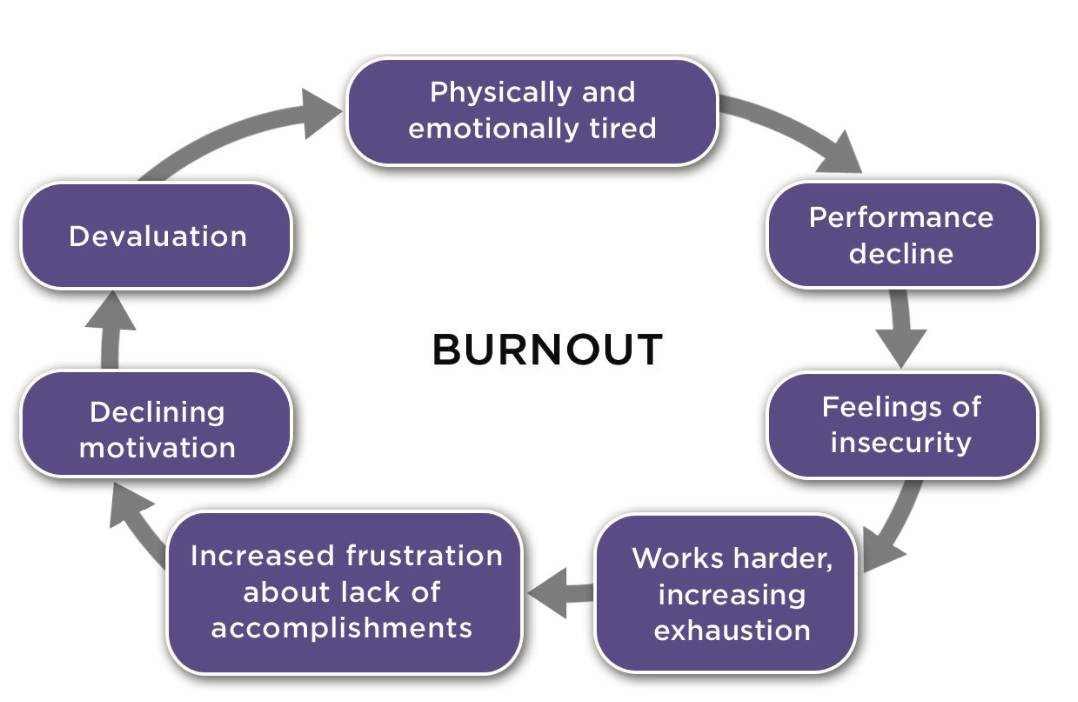Intro¶
Note
This burnout guide is a WIP. It currently only covers 3/8 parts which includes how I ended up being burnt out. I'm hoping to publish the last 5 parts by Feb 2024, which covers how I got out of it 
I’ve started to notice signs of burnout in 2019. At first I didn’t want to believe it, but after reading stories about burnout, I’ve decided to do some research and reflect on it. I ended up going down a rabbit hole, spending hundreds of hours reading, writing, and reflecting on it, not including the additional hundreds of hours of therapy or spiritual modalities I’ve done and the five year process recovering from it. From this I’ve developed my own theory of burnout that describes my specific case of burnout. This theory distinguishes itself from other writing on burnout in that it is an internal, individual-focused, and process-oriented model of burnout. There are plenty of research emphasizing on external models of burnout (e.g. looking at external stressors), organizational-focused (e.g. looking at organizational factors like a bad boss or toxic culture), and factor-oriented (looking at contributing factors to burnout), but they didn’t sufficiently explain my case well enough so I am writing a new one.
Burnout is a very vulnerable and stigmatized topic in the public sphere and potentially very career-limiting. I originally wrote this for myself to help me understanding my own situation. However, as I slowly confided to close friends about my mental health, not only were they extremely supportive, I soon discovered a lot of my friends struggled with similar issues in their lives. When I hear about other people struggle with the same problems I went through, I am consistently inspired to eventually share and publish this piece to give other folks potential clarity for what they're experiencing. I hope those who are struggling will find something here that they might relate to or something that can help them in their own lives.
So if you’re ready to learn more about burnout, strap in your seat belt and let’s go for a ride. This series is broken into 8 parts across two halves. The first half, consisting of three parts is about understanding burnout and how I ended up burnt out. The second half, of four parts, is a journalistic recounting on how I got out of it. We'll end the series with a conclusion and summary. I wrote the majority of the first half in 2020 when I wanted to understand why I was burnt out. I wrote the majority of second half four years later in 2024 when I made enough progress in my recovery to remove my personal label of being burnt out.
Here's an outline:
- Getting into burnout
- Research of burnout: We'll introduce some of the existing research of burnout so we can develop a framework and vocabulary for understanding burnout.
- Personal experience with burnout: We'll go on several thematic tangents related to burnout that I've personally experienced.
- Complete burnout model: We'll combine the research and personal experience together to build a complete burnout model and diagram to understand the system that creates and sustains burnout.
- Getting out of burnout (not published yet!)
- Self regulation: We'll talk about the strategies I've employed to regulate my burnout and in what ways they've fallen short
- Self Therapy: We'll talk about the ways I've tried to therapize myself.
- Getting Help: We'll talk about the ways I've gotten help from the different spiritual practices and therapy modulaties.
- Finding Engagement: We'll talk about how I've been able to fully re-engage with life again
- Summary & Conclusion: We'll ponder about how my experience and journey can help you with your burnout or mental health issues.
Existing Research on Burnout¶
While I was researching burnout models I came across multiple theories of burnout. Almost every researcher agrees that burnout is caused by chronic exposure to stress. With that, there is also a growing amount of consensus that there is a physiological manifestation of burnout, not simply psychological. Armita Golkar, lead author and psychologist at Karolinska Institutet in Sweden, studied the brains of burnt out individuals in 2014 and shown that burnt out individuals have shown to have larger amygdalas (structures of the brain control for fear and aggression) and lower connectivity between the medial prefrontal-cortex and the amygdala (a part of the brain that modulates the amygdala to tune down the stress response). They were shown to have impaired emotional regulation, and that begins a vicious cycle at the biological level for treating burnout -- unresolved stress itself causes more stress and chronic stress impairs our ability to manage stress.
One of the early pioneers of understanding the psychological root causes of burnout was Christina Maslach, famous for her Maslach Burnout Inventory in 1976. Her burnout inventory marked a major milestone in diagnosing burnout in individuals and recognizing burnout as a legitimate medical condition and not just something “in your head”.
Maslach’s diagnosis (one of the most widely-accepted diagnosis) of burnout consists of identifying three main traits -- exhaustion, cynicism, and inefficacy. The field is fairly new, such that there is still some debate about what symptoms are actual core components of diagnosing burnout. Some may argue you can be efficient or optimistic while burnt out, however, almost no one disagrees that exhaustion is a core component of a burnout diagnosis. My take on burnout is that exhaustion is pretty much the only core component of burnout,, and the latter two are downstream consequences of exhaustion. I believe this because studies have demonstrated exhaustion as one of the earliest signs of burnout, and I have proposed causal paths that describe how exhaustion can contribute to cynicism (via dysfunctional emotional regulation) and inefficacy (via lack of energy).
As groundbreaking as Maslach’s research, her research kind of just stops there. It was purely a diagnostic tool and it didn’t really propose a theory of how an individual ends up with these symptoms1. Reviews of her books tend to say that her level of rigor doesn’t really extend into her advice to getting out of burnout and it kind of hand-waves that entire process.
A common pattern in burnout research is researching burnout in the context of a job environment and finding contributing factors of burnout in the environment (in contrast to the individual). For example, in Leiter and Maslach’s book “The Truth About Burnout: How Organizations Cause Personal Stress and What to Do About It”, they identified six organizational factors that contribute to burnout:
- Workload
- Control: The subjective sense of agency in one's work
- Reward
- Community
- Fairness: The extent to which decision-making is seen to be just and equitable.
- Values: Difference of values between the individual and the organization
While this was valid, I felt it didn’t explain the cause of MY burnout. I’ve experienced some of these factors, but objectively throughout the tech industry these factors weren’t bad enough to be the sole cause of my burnout. IT ranks fairly low as an industry with rates of burnout. My experience with my work seems to indicate that these organizational factors are actually to some degree, subjective. In the tech sector, many of these organizational factors are pretty good compared other industries. It seems that there are objective circumstances paired with subjective interpretation that causes burnout. Not too similar to studying gene-environment interactions, I was looking for the individual’s contribution to the burnout process.
Serendipitously, I came across some research about burnout in some sports psychology literature and learned about Ronald E. Smith’s research on burnout in 1986. Smith studied burnout in the context of athletic sports. He proposed an individual-centric process that described a process towards burnout in professional athletes.

I found this diagram extremely confusing but it can be summarized from this outline and diagram from “The Psychology of Performance” by sports psychologist Eddie O’Connor :
- The first stage is the demands of the sport -- time, training, relationships, and pressure
- In the second stage, the athlete meets these demands. If they can handle them, then everything is good. But if he or she feels that they can’t handle them because of a lack of skills, time, energy, good coaching, money, or emotional support then
- The third stage of the physiological response is initiated: the stress response.
- This triggers the coping behaviors in the final stage.
- Some are positive, such as rest, working harder, or seeking support.
- Some can be maladaptive, such as working harder when rest is needed or avoidance.

I prefer Smith’s model, since it described a vicious cycle of burnout that was much more congruent with my experience with it. It also was individual-focus and applied broadly to life rather focused mainly on work. The missing gaps in Smith’s research was how people end up in this cycle and how cognitive evaluations factored into this process. There were clearly some internal processes going on that influenced how much stress we experienced.
I then took some time to read into cognitive behavioral therapy. I also attended therapy for several months 2 . The most relevant portion that I’ve read was about schemas, or automatic/distorted thought patterns that we develop or grow up with. Knowing schemas tend to be extremely varied and personal, I realized I needed to do some self-reflection. With this foray into personal, subjective interpretations, we can begin exploring these tangents.
-
My second criticism is that it costs $50 to obtain an individual license to use her burnout inventory. ↩
-
I think everyone should do therapy if they can afford it. But as a matter of pride, I don’t think my therapists helped me uncover these truths about burnout above outside of being a really good commitment device for regular self-reflection ↩